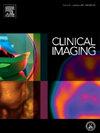Ultimate focus: applications of the Churchill Method in radiology
IF 1.5
4区 医学
Q3 RADIOLOGY, NUCLEAR MEDICINE & MEDICAL IMAGING
引用次数: 0
Abstract
The Churchill Method evolved as an approach to shooting sporting clays; essentially, successfully shooting the clay as it followed its multi-dimensional trajectory could be distilled into a simplified task, with well-trained instinct taking over to allow achievement of the more complex overall task. The simplified task might be ultimate focus on finding the leading edge of the target – with instinctive hand-eye coordination handling everything else including bringing the barrel into alignment. If the instinct is not present, the Churchill Method will not work – and practice and repetition must be utilized in order for there to be success with the overall goal. Those ideas can inform multiple aspects of radiology practice, from day-to-day, hands-on procedures to long-term career building. Regarding procedures, the Churchill Method can instruct us to keep our focus on the screen or monitor, while letting our honed instincts guide our hands to where they need to be for maximal efficacy. In the context of diagnostic imaging, fleeting ultimate focus can intersect with specific, high-yield areas of the anatomy in instinctively defined search patterns. As for career building, the Churchill Method suggests that ultimate focus on the next paper or the next grant or the next important talk can instinctively allow us to achieve our long-term career goals. With the rapid rise of artificial intelligence (AI), approaches such as the Churchill Method that can maximize human achievement are important to ensure that human endeavor remains relevant as many tasks begin to fall under the AI umbrella.
终极焦点:丘吉尔方法在放射学中的应用
邱吉尔法演变为一种射击运动粘土的方法;从本质上讲,成功地射击粘土,因为它遵循其多维轨迹可以提炼成一个简单的任务,训练有素的本能接管,允许实现更复杂的整体任务。简化的任务可能是最终集中在找到目标的前沿——用本能的手眼协调来处理其他一切,包括使枪管对齐。如果没有这种本能,丘吉尔方法就不会起作用——为了实现总体目标,必须利用练习和重复。这些想法可以为放射学实践的多个方面提供信息,从日常的实际操作程序到长期的职业建设。在程序方面,丘吉尔方法可以指导我们将注意力集中在屏幕或显示器上,同时让我们磨练过的本能引导我们的手到需要的地方,以获得最大的功效。在诊断成像的背景下,短暂的最终焦点可以在本能定义的搜索模式中与特定的、高收益的解剖区域相交。至于职业建设,邱吉尔方法认为,把最终的注意力放在下一篇论文、下一笔拨款或下一个重要的演讲上,可以本能地让我们实现长期的职业目标。随着人工智能(AI)的迅速崛起,像丘吉尔方法这样可以最大化人类成就的方法对于确保人类努力保持相关性至关重要,因为许多任务开始落入人工智能的保护伞之下。
本文章由计算机程序翻译,如有差异,请以英文原文为准。
求助全文
约1分钟内获得全文
求助全文
来源期刊

Clinical Imaging
医学-核医学
CiteScore
4.60
自引率
0.00%
发文量
265
审稿时长
35 days
期刊介绍:
The mission of Clinical Imaging is to publish, in a timely manner, the very best radiology research from the United States and around the world with special attention to the impact of medical imaging on patient care. The journal''s publications cover all imaging modalities, radiology issues related to patients, policy and practice improvements, and clinically-oriented imaging physics and informatics. The journal is a valuable resource for practicing radiologists, radiologists-in-training and other clinicians with an interest in imaging. Papers are carefully peer-reviewed and selected by our experienced subject editors who are leading experts spanning the range of imaging sub-specialties, which include:
-Body Imaging-
Breast Imaging-
Cardiothoracic Imaging-
Imaging Physics and Informatics-
Molecular Imaging and Nuclear Medicine-
Musculoskeletal and Emergency Imaging-
Neuroradiology-
Practice, Policy & Education-
Pediatric Imaging-
Vascular and Interventional Radiology
 求助内容:
求助内容: 应助结果提醒方式:
应助结果提醒方式:


